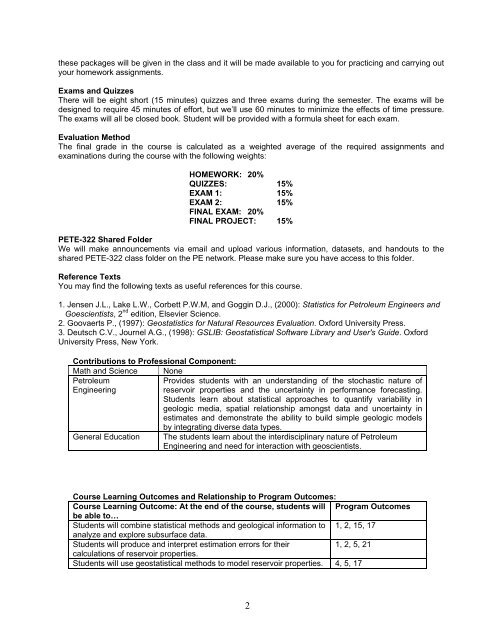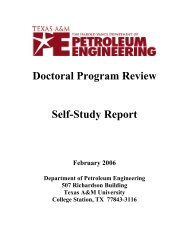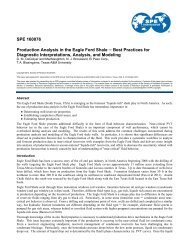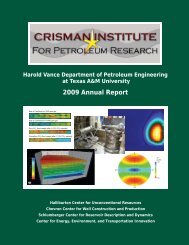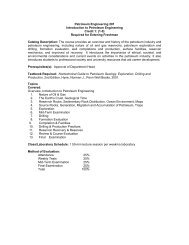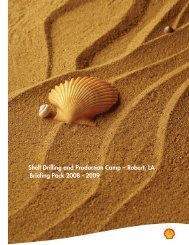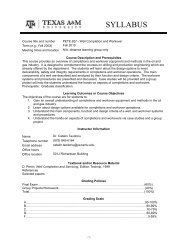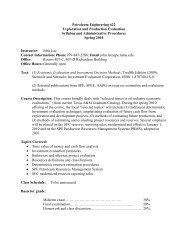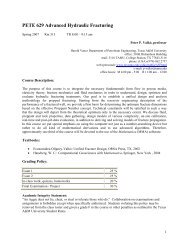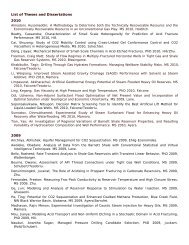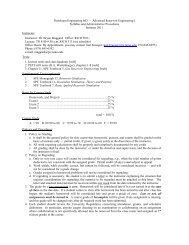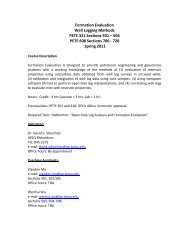Nontechnical Guide to Petroleum Geology, Exploration
Nontechnical Guide to Petroleum Geology, Exploration
Nontechnical Guide to Petroleum Geology, Exploration
You also want an ePaper? Increase the reach of your titles
YUMPU automatically turns print PDFs into web optimized ePapers that Google loves.
these packages will be given in the class and it will be made available <strong>to</strong> you for practicing and carrying out<br />
your homework assignments.<br />
Exams and Quizzes<br />
There will be eight short (15 minutes) quizzes and three exams during the semester. The exams will be<br />
designed <strong>to</strong> require 45 minutes of effort, but we’ll use 60 minutes <strong>to</strong> minimize the effects of time pressure.<br />
The exams will all be closed book. Student will be provided with a formula sheet for each exam.<br />
Evaluation Method<br />
The final grade in the course is calculated as a weighted average of the required assignments and<br />
examinations during the course with the following weights:<br />
HOMEWORK: 20%<br />
QUIZZES: 15%<br />
EXAM 1: 15%<br />
EXAM 2: 15%<br />
FINAL EXAM: 20%<br />
FINAL PROJECT: 15%<br />
PETE-322 Shared Folder<br />
We will make announcements via email and upload various information, datasets, and handouts <strong>to</strong> the<br />
shared PETE-322 class folder on the PE network. Please make sure you have access <strong>to</strong> this folder.<br />
Reference Texts<br />
You may find the following texts as useful references for this course.<br />
1. Jensen J.L., Lake L.W., Corbett P.W.M, and Goggin D.J., (2000): Statistics for <strong>Petroleum</strong> Engineers and<br />
Goescientists, 2 nd edition, Elsevier Science.<br />
2. Goovaerts P., (1997): Geostatistics for Natural Resources Evaluation. Oxford University Press.<br />
3. Deutsch C.V., Journel A.G., (1998): GSLIB: Geostatistical Software Library and User's <strong>Guide</strong>. Oxford<br />
University Press, New York.<br />
Contributions <strong>to</strong> Professional Component:<br />
Math and Science None<br />
<strong>Petroleum</strong><br />
Provides students with an understanding of the s<strong>to</strong>chastic nature of<br />
Engineering<br />
reservoir properties and the uncertainty in performance forecasting.<br />
Students learn about statistical approaches <strong>to</strong> quantify variability in<br />
geologic media, spatial relationship amongst data and uncertainty in<br />
estimates and demonstrate the ability <strong>to</strong> build simple geologic models<br />
by integrating diverse data types.<br />
General Education The students learn about the interdisciplinary nature of <strong>Petroleum</strong><br />
Engineering and need for interaction with geoscientists.<br />
Course Learning Outcomes and Relationship <strong>to</strong> Program Outcomes:<br />
Course Learning Outcome: At the end of the course, students will Program Outcomes<br />
be able <strong>to</strong>…<br />
Students will combine statistical methods and geological information <strong>to</strong> 1, 2, 15, 17<br />
analyze and explore subsurface data.<br />
Students will produce and interpret estimation errors for their<br />
1, 2, 5, 21<br />
calculations of reservoir properties.<br />
Students will use geostatistical methods <strong>to</strong> model reservoir properties. 4, 5, 17<br />
2


